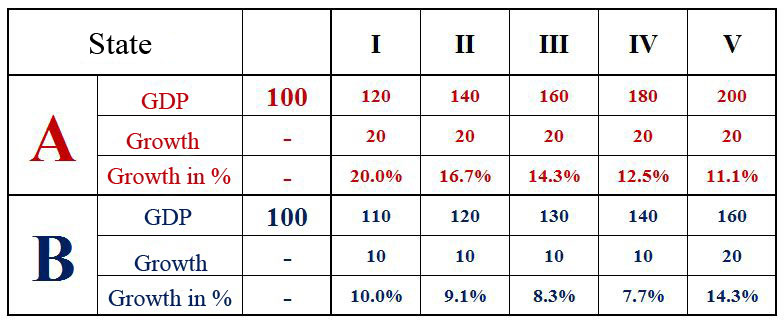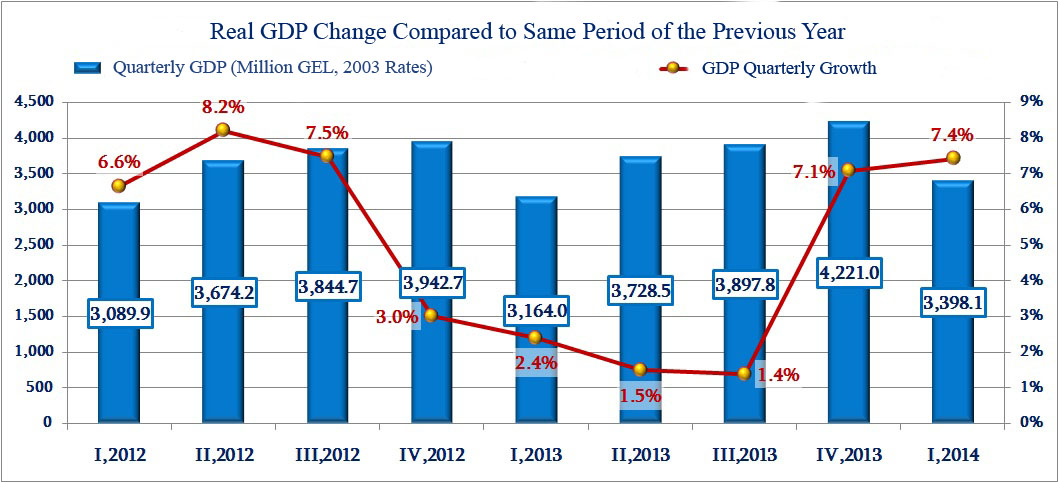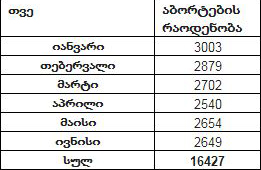On 2 April 2014 at the Parliament’s plenary session, representative of the Minority, MP Zurab Japaridze, stated: “I hope you don’t really believe that the Georgian economy is on an irreversible rising tide. The numbers which were published in November, December and January are the result of the so-called ‘“base effect.”’ These months are compared to the same months of the previous year and that is why you have shown some growth.”
The MP later made a similar statement on Rustavi2’s “Business Courier” where he discussed the “base effect” more extensively.
FactCheck took interest in the MP’s statement and verified its accuracy.
In economics and business, the “base effect”, or the low initial amount indicator effect, is a situation when a small absolute change from a low initial amount results in a bigger growth in percentage.
Table 1: Example of “Base Effect”
 Let us take for an example two states – A and B (as in Table 1 above). The initial GDP of both states is GEL 100 million. In state A, the annual GDP growth is 20 units whereas in state B, the annual GDP growth for the first four years is 10 units and in the 5th year it amounts to 20 units. In the 4th year, the GDP of state A is equal to 180 units, while in state B – it is 140. In the 5th year, GDP change by 20 units results in 11.1% growth in state A and 14.3% in state B.
Despite the fact that the GDP growth in both states was equal to 20 units, the growth in percentage in the 5th year is higher in state B than in state A. At the same time, the GDP of state A is bigger at the end of the 5th year than the GDP of state B. Hence, in order to determine which one of the countries was more successful during the past five years, focusing on the percentage growth of only the 5th year is not the best option.
What Zurab Japaridze had in mind, when making his statement, was the low real growth of the Georgian GDP from the 4th quarter of 2012 to the 3rd quarter of 2013. He believes that the high GDP growth in the last quarter of 2013 and the 1st quarter of 2014 is the result of the “base effect” but, in reality, there is no growth.
Chart 1.
Let us take for an example two states – A and B (as in Table 1 above). The initial GDP of both states is GEL 100 million. In state A, the annual GDP growth is 20 units whereas in state B, the annual GDP growth for the first four years is 10 units and in the 5th year it amounts to 20 units. In the 4th year, the GDP of state A is equal to 180 units, while in state B – it is 140. In the 5th year, GDP change by 20 units results in 11.1% growth in state A and 14.3% in state B.
Despite the fact that the GDP growth in both states was equal to 20 units, the growth in percentage in the 5th year is higher in state B than in state A. At the same time, the GDP of state A is bigger at the end of the 5th year than the GDP of state B. Hence, in order to determine which one of the countries was more successful during the past five years, focusing on the percentage growth of only the 5th year is not the best option.
What Zurab Japaridze had in mind, when making his statement, was the low real growth of the Georgian GDP from the 4th quarter of 2012 to the 3rd quarter of 2013. He believes that the high GDP growth in the last quarter of 2013 and the 1st quarter of 2014 is the result of the “base effect” but, in reality, there is no growth.
Chart 1.
 Source: National Statistics Office of Georgia, geostat.ge
From Chart 1 it is clear that GDP growth rates in the last quarter of 2013 and the 1st quarter of 2014 are among the highest (based upon percentage change since the 1st quarter of 2012). Such high figures (4th quarter 2013 – 7.1% and 1st quarter 2014 – 7.4%) are indeed mainly due to the “base effect”, however the economic conditions in the country could have worsened so much that it would not have even this amount of growth.
In order to determine whether or not the economic condition of the country really improved, besides the changes in GDP percentage, we need to look into absolute GDP growth as well.
Chart 2.
Source: National Statistics Office of Georgia, geostat.ge
From Chart 1 it is clear that GDP growth rates in the last quarter of 2013 and the 1st quarter of 2014 are among the highest (based upon percentage change since the 1st quarter of 2012). Such high figures (4th quarter 2013 – 7.1% and 1st quarter 2014 – 7.4%) are indeed mainly due to the “base effect”, however the economic conditions in the country could have worsened so much that it would not have even this amount of growth.
In order to determine whether or not the economic condition of the country really improved, besides the changes in GDP percentage, we need to look into absolute GDP growth as well.
Chart 2.
 Source: National Statistics Office of Georgia, geostat.ge
From Chart 2, it is clear that in the last quarter of 2013 and the 1st quarter of 2014 there was a substantial growth in [absolute] GDP (4th quarter 2013 – GEL 278.3 million, and 1st quarter 2014 – GEL 234.1 million).
If the GDP of the 4th quarter of 2013 and the 1st quarter of 2014 would stay the same and increase in the last quarter of 2012 and the 1st quarter of 2013, then, of course, growth – both absolute and in percentage at the end of 2013 and the beginning of 2014 – would be much less. However, the high level of the GDP at the end of 2012 and the beginning of 2013 would stimulate the economy and could trigger both absolute and percentage growth of the GDP in the last quarter of 2013 and the 1st quarter of 2014.
Conclusion
In economics and business, the “base effect” or the low initial amount indicator effect, is a situation when a small absolute change from a low initial amount results in a bigger growth in percentage. If we take the example of two states, if the GDPs of both states grow with the same absolute amount, the state with the lower initial GDP will show a bigger growth in percentage.
From the above analysis, it is clear that both percentage and absolute growth was high at the end of 2013 and the beginning of 2014. In general, when the economy of a developing state begins to grow, its growth rate is usually higher than that of a developed country. This is another example of the “base effect”. Even though from the last quarter of 2012 to the 3rd quarter of 2013 (when the Georgian Dream coalition was already in power) Georgia had low real growth rates in GDP, at the end of 2013 and the beginning of 2014 (the Georgian Dream still being in government) the GDP growth rates started to rise. This rise is, indeed, somewhat due to the “base effect”, however the economic conditions in the country could have worsened so much that it would not have even this amount of growth. So, we definitely see tendencies towards improvement in the Georgian economy. The future will show whether or not these tendencies are irreversible.
We conclude that Zurab Japaridze’s statement, “I hope you don’t really believe that the Georgian economy is on an irreversible rising tide. The numbers which were published in November, December and January are the result of the so-called ‘“base effect”’. These months are compared to the same months of the previous year and that is why you have shown some growth,” is HALF TRUE.
Source: National Statistics Office of Georgia, geostat.ge
From Chart 2, it is clear that in the last quarter of 2013 and the 1st quarter of 2014 there was a substantial growth in [absolute] GDP (4th quarter 2013 – GEL 278.3 million, and 1st quarter 2014 – GEL 234.1 million).
If the GDP of the 4th quarter of 2013 and the 1st quarter of 2014 would stay the same and increase in the last quarter of 2012 and the 1st quarter of 2013, then, of course, growth – both absolute and in percentage at the end of 2013 and the beginning of 2014 – would be much less. However, the high level of the GDP at the end of 2012 and the beginning of 2013 would stimulate the economy and could trigger both absolute and percentage growth of the GDP in the last quarter of 2013 and the 1st quarter of 2014.
Conclusion
In economics and business, the “base effect” or the low initial amount indicator effect, is a situation when a small absolute change from a low initial amount results in a bigger growth in percentage. If we take the example of two states, if the GDPs of both states grow with the same absolute amount, the state with the lower initial GDP will show a bigger growth in percentage.
From the above analysis, it is clear that both percentage and absolute growth was high at the end of 2013 and the beginning of 2014. In general, when the economy of a developing state begins to grow, its growth rate is usually higher than that of a developed country. This is another example of the “base effect”. Even though from the last quarter of 2012 to the 3rd quarter of 2013 (when the Georgian Dream coalition was already in power) Georgia had low real growth rates in GDP, at the end of 2013 and the beginning of 2014 (the Georgian Dream still being in government) the GDP growth rates started to rise. This rise is, indeed, somewhat due to the “base effect”, however the economic conditions in the country could have worsened so much that it would not have even this amount of growth. So, we definitely see tendencies towards improvement in the Georgian economy. The future will show whether or not these tendencies are irreversible.
We conclude that Zurab Japaridze’s statement, “I hope you don’t really believe that the Georgian economy is on an irreversible rising tide. The numbers which were published in November, December and January are the result of the so-called ‘“base effect”’. These months are compared to the same months of the previous year and that is why you have shown some growth,” is HALF TRUE.
 Let us take for an example two states – A and B (as in Table 1 above). The initial GDP of both states is GEL 100 million. In state A, the annual GDP growth is 20 units whereas in state B, the annual GDP growth for the first four years is 10 units and in the 5th year it amounts to 20 units. In the 4th year, the GDP of state A is equal to 180 units, while in state B – it is 140. In the 5th year, GDP change by 20 units results in 11.1% growth in state A and 14.3% in state B.
Despite the fact that the GDP growth in both states was equal to 20 units, the growth in percentage in the 5th year is higher in state B than in state A. At the same time, the GDP of state A is bigger at the end of the 5th year than the GDP of state B. Hence, in order to determine which one of the countries was more successful during the past five years, focusing on the percentage growth of only the 5th year is not the best option.
What Zurab Japaridze had in mind, when making his statement, was the low real growth of the Georgian GDP from the 4th quarter of 2012 to the 3rd quarter of 2013. He believes that the high GDP growth in the last quarter of 2013 and the 1st quarter of 2014 is the result of the “base effect” but, in reality, there is no growth.
Chart 1.
Let us take for an example two states – A and B (as in Table 1 above). The initial GDP of both states is GEL 100 million. In state A, the annual GDP growth is 20 units whereas in state B, the annual GDP growth for the first four years is 10 units and in the 5th year it amounts to 20 units. In the 4th year, the GDP of state A is equal to 180 units, while in state B – it is 140. In the 5th year, GDP change by 20 units results in 11.1% growth in state A and 14.3% in state B.
Despite the fact that the GDP growth in both states was equal to 20 units, the growth in percentage in the 5th year is higher in state B than in state A. At the same time, the GDP of state A is bigger at the end of the 5th year than the GDP of state B. Hence, in order to determine which one of the countries was more successful during the past five years, focusing on the percentage growth of only the 5th year is not the best option.
What Zurab Japaridze had in mind, when making his statement, was the low real growth of the Georgian GDP from the 4th quarter of 2012 to the 3rd quarter of 2013. He believes that the high GDP growth in the last quarter of 2013 and the 1st quarter of 2014 is the result of the “base effect” but, in reality, there is no growth.
Chart 1.
 Source: National Statistics Office of Georgia, geostat.ge
From Chart 1 it is clear that GDP growth rates in the last quarter of 2013 and the 1st quarter of 2014 are among the highest (based upon percentage change since the 1st quarter of 2012). Such high figures (4th quarter 2013 – 7.1% and 1st quarter 2014 – 7.4%) are indeed mainly due to the “base effect”, however the economic conditions in the country could have worsened so much that it would not have even this amount of growth.
In order to determine whether or not the economic condition of the country really improved, besides the changes in GDP percentage, we need to look into absolute GDP growth as well.
Chart 2.
Source: National Statistics Office of Georgia, geostat.ge
From Chart 1 it is clear that GDP growth rates in the last quarter of 2013 and the 1st quarter of 2014 are among the highest (based upon percentage change since the 1st quarter of 2012). Such high figures (4th quarter 2013 – 7.1% and 1st quarter 2014 – 7.4%) are indeed mainly due to the “base effect”, however the economic conditions in the country could have worsened so much that it would not have even this amount of growth.
In order to determine whether or not the economic condition of the country really improved, besides the changes in GDP percentage, we need to look into absolute GDP growth as well.
Chart 2.
 Source: National Statistics Office of Georgia, geostat.ge
From Chart 2, it is clear that in the last quarter of 2013 and the 1st quarter of 2014 there was a substantial growth in [absolute] GDP (4th quarter 2013 – GEL 278.3 million, and 1st quarter 2014 – GEL 234.1 million).
If the GDP of the 4th quarter of 2013 and the 1st quarter of 2014 would stay the same and increase in the last quarter of 2012 and the 1st quarter of 2013, then, of course, growth – both absolute and in percentage at the end of 2013 and the beginning of 2014 – would be much less. However, the high level of the GDP at the end of 2012 and the beginning of 2013 would stimulate the economy and could trigger both absolute and percentage growth of the GDP in the last quarter of 2013 and the 1st quarter of 2014.
Conclusion
In economics and business, the “base effect” or the low initial amount indicator effect, is a situation when a small absolute change from a low initial amount results in a bigger growth in percentage. If we take the example of two states, if the GDPs of both states grow with the same absolute amount, the state with the lower initial GDP will show a bigger growth in percentage.
From the above analysis, it is clear that both percentage and absolute growth was high at the end of 2013 and the beginning of 2014. In general, when the economy of a developing state begins to grow, its growth rate is usually higher than that of a developed country. This is another example of the “base effect”. Even though from the last quarter of 2012 to the 3rd quarter of 2013 (when the Georgian Dream coalition was already in power) Georgia had low real growth rates in GDP, at the end of 2013 and the beginning of 2014 (the Georgian Dream still being in government) the GDP growth rates started to rise. This rise is, indeed, somewhat due to the “base effect”, however the economic conditions in the country could have worsened so much that it would not have even this amount of growth. So, we definitely see tendencies towards improvement in the Georgian economy. The future will show whether or not these tendencies are irreversible.
We conclude that Zurab Japaridze’s statement, “I hope you don’t really believe that the Georgian economy is on an irreversible rising tide. The numbers which were published in November, December and January are the result of the so-called ‘“base effect”’. These months are compared to the same months of the previous year and that is why you have shown some growth,” is HALF TRUE.
Source: National Statistics Office of Georgia, geostat.ge
From Chart 2, it is clear that in the last quarter of 2013 and the 1st quarter of 2014 there was a substantial growth in [absolute] GDP (4th quarter 2013 – GEL 278.3 million, and 1st quarter 2014 – GEL 234.1 million).
If the GDP of the 4th quarter of 2013 and the 1st quarter of 2014 would stay the same and increase in the last quarter of 2012 and the 1st quarter of 2013, then, of course, growth – both absolute and in percentage at the end of 2013 and the beginning of 2014 – would be much less. However, the high level of the GDP at the end of 2012 and the beginning of 2013 would stimulate the economy and could trigger both absolute and percentage growth of the GDP in the last quarter of 2013 and the 1st quarter of 2014.
Conclusion
In economics and business, the “base effect” or the low initial amount indicator effect, is a situation when a small absolute change from a low initial amount results in a bigger growth in percentage. If we take the example of two states, if the GDPs of both states grow with the same absolute amount, the state with the lower initial GDP will show a bigger growth in percentage.
From the above analysis, it is clear that both percentage and absolute growth was high at the end of 2013 and the beginning of 2014. In general, when the economy of a developing state begins to grow, its growth rate is usually higher than that of a developed country. This is another example of the “base effect”. Even though from the last quarter of 2012 to the 3rd quarter of 2013 (when the Georgian Dream coalition was already in power) Georgia had low real growth rates in GDP, at the end of 2013 and the beginning of 2014 (the Georgian Dream still being in government) the GDP growth rates started to rise. This rise is, indeed, somewhat due to the “base effect”, however the economic conditions in the country could have worsened so much that it would not have even this amount of growth. So, we definitely see tendencies towards improvement in the Georgian economy. The future will show whether or not these tendencies are irreversible.
We conclude that Zurab Japaridze’s statement, “I hope you don’t really believe that the Georgian economy is on an irreversible rising tide. The numbers which were published in November, December and January are the result of the so-called ‘“base effect”’. These months are compared to the same months of the previous year and that is why you have shown some growth,” is HALF TRUE.








